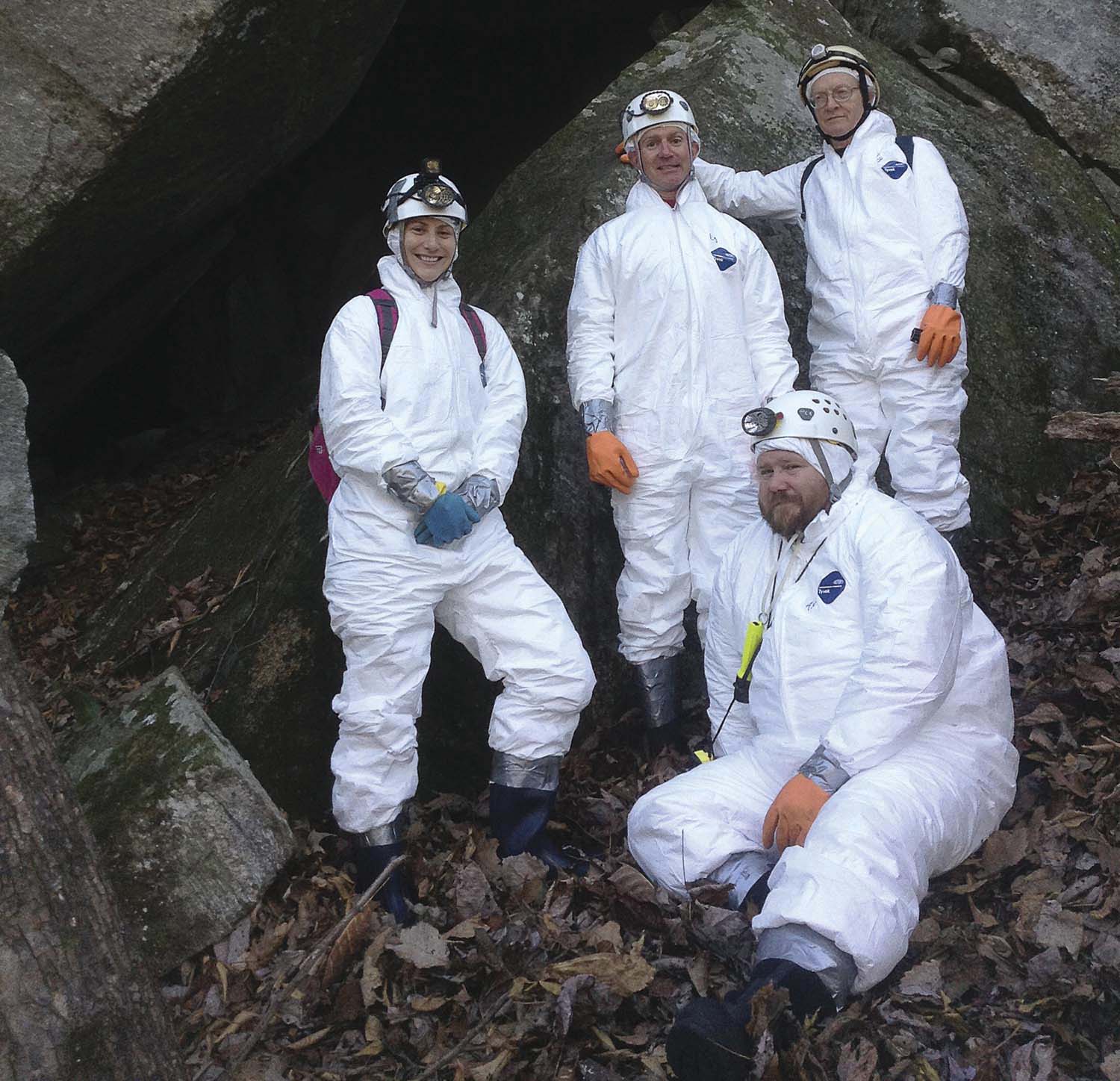
At Bat Cave Preserve, conservation experts have taken the place of hikers, thanks to the ravages wrought by White Nose Syndrome.
When Karl Schwartz lived in Florida, folks knew him as the “snake king” because he raised Burmese Pythons for extra cash — $200 wholesale and $400 retail. But the moniker also lent itself to his fondness for what many consider a vile, slithering creature.
Now retired in the Tryon area, Schwartz is fighting to defend a species he says is similar to snakes, in reputation at least. “I like bats,” he explains. “Other people associate them with diseases and vampires, or think they’re going to fly into their hair, but I like them.”
Schwartz will lead a bat-house-making workshop at the Tryon Arts and Crafts School on Friday, October 13. (The date is appropriately spooky, though not intentional.) Participants will hammer together a 2’x2’ wooden box, which can later be mounted on a pole in their backyard. Most experts suggest placing the box 12 to 20 feet off the ground. (They also warn against fixing it to a tree, as limbs block direct sunlight.)
Once installed, these bijou bungalows don’t look like much (think a large birdhouse or clunky mail box), but the increasingly trendy structures can hold more than 200 roosting bats. Mesh stapled to the inside allows the critters to hang upside down, while a predator guard keeps hawks and owls out. “You have to be a bat to get inside,” quips Schwartz.
His workshop joins ongoing efforts to preserve Western North Carolina’s declining bat populations. According to the North Carolina Wildlife Resource Commission, specific sites in Avery, Haywood, and McDowell Counties have lost more than 3,000 bats since 2011. Just south of Hendersonville in Bat Cave — an aptly named community that makes the national list of “Unusual Place Names” on Wikipedia — populations have been decimated by White Nose Syndrome (WNS), a deadly fungus that covers a bat’s muzzle and wings during hibernation. But it’s not the fungus that kills the bat, per se. “WNS causes bats to awaken mid hibernation [October to early spring] and need to eat, which contributes to starvation,” explains Adam Warwick, Southern Blue Ridge Stewardship Manager for The Nature Conservancy. Warwick and his team, which includes Stewardship Assistant Mamie Colburn, work to protect 8,000 acres of natural lands throughout Western North Carolina. Their coverage area includes the 186-acre Bat Cave Preserve, a predominantly north-facing oak and hickory forest with steep slopes and rocky outcroppings. Up until 2009, people could tour Bat Cave, catching a glimpse of the rare Crevice Salamander (Plethodon yonahlossee) and exploring what is considered the largest granite-fissure cave in North America. But staff shut the area down shortly after White Nose Syndrome was reported at New York’s Howe Caverns in 2006.
“By limiting the number of people who can go inside the caves, we were hoping to reduce the spread and reintroduction of WNS,” says Colburn, noting that spores from the microscopic fungus can hitchhike on shoes, clothing, and bags. Now, even when researchers enter the caves, they must wear a Tyvek suit.
The whole undertaking is reminiscent of that heart-wrenching scene when scientists come to take E.T. from his bipedal juvenile, Elliott. It’s eerie, and, honestly, a little depressing. Especially when you consider that these measures are only preventative. Though scientists are toying with solutions to WNS, even treating afflicted bats in Missouri, there currently is no cure-all.
Which is bad news for everyone — not just the fuzzy, winged mammals. Declining bat populations could cause an ecological domino effect. As WNS spreads and habitat destruction wages on, there will be fewer bats to eat ants, moths, crickets, and other creepy crawlies. (One brown bat can eat up to 1,000 mosquitoes in an hour, according to some research Schwartz pulled together.) Increased insect numbers could mean increased crop damage; the U.S. Geological Survey estimates a $3.7 billion loss in agriculture.
“This is the reality when it comes to exotic or alien species,” says Warwick. “The story is always the same.” He mentions the Balsam woolly adelgid, a species of wingless insects that have devastated fir trees, especially hemlocks, and the more infamous Japanese arrowroot — aka kudzu. Creeping down highways and into pastureland, kudzu eats up $500 million annually in lost cropland and control costs. “Exotic species are among the top threats to the biodiversity of the Southern Appalachians,” he says.
But for some, like Colburn, saving native species is about more than eluding economic ruin.
“The few bats I saw inside Bat Cave this winter looked so defenseless as they slept, hibernating along the cave walls,” she says. “In summer, I just love the time after sunset when bats fly around overhead like dark shadows outlined on a dusky sky.” Then, as an afterthought, she adds: “Don’t we all need an underdog to root for?”
Schwartz believes so. Though no bats have yet moved into his backyard bat boxes — painted a stylish black and outfitted with cedar planks for aroma — he’s still hopeful. “Everyone is fighting for their cause,” he says. “This is mine.”
Karl Schwartz’s “Making a Bat House” workshop happens Friday, October 13, 6-8pm, at the Tryon Arts and Crafts School (373 Harmon Field Road). $45 per participant. For more information, call (828) 859-8323 or visit tryonartsandcrafts.org. To learn more about The Nature Conservancy’s efforts to prevent White Nose Syndrome at Bat Cave Preserve, visit nature.org.
